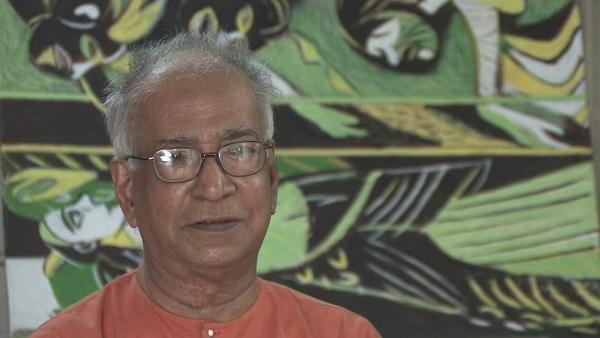NEXT STORY

Are crafts still alive in India today?
RELATED STORIES

NEXT STORY

Are crafts still alive in India today?
RELATED STORIES



Did you not also import into the faculty sometimes craftsmen from traditional…
Yes, we do, we did, yes. It all started when we sort of persuaded the university to appoint traditional craftsmen as my assistants in the mural section. Thereafter, I thought that what Nandalal did at one time in the beginning of Kala Bhavan we should also do. That is, we wanted to have people from the various areas of craft, handicraft in different parts of India to come and demonstrate their work, and probably we could learn something from them, and probably this interaction will be very useful to the students. At one time of course it was not taken or looked upon very kindly. They thought I was a kind of traditionalist who was trying to go the opposite way, but then, now of course it is no more so. I mean people appreciate that, and it is being sort of continued in various different ways. But my main idea at that time was a little different. I wanted that whenever a man is practicing then all the things of his practice should be documented and then it will become a kind of a source book of craft practice for the artists to draw their resource from. That never happened fully. That never happened. In fact, some of my students have continued things piecemeal, like photographic documentation. I mean my junior colleagues like Kanaria have continued. Some amount of ethnographical classification and then documentation Harku Shah has done, and along with Eberhard Fischer, they have produced a book in which they very laboriously documented the process and things of that kind. But in a place like India we need a whole encyclopaedia of crafts with all these things documented, and my whole idea was only this, that whether it is useful to us it is a kind of cultural treasure we cannot let lapse into oblivion. The other thing is that how do we know? Maybe this knowledge can be an incentive for further knowledge when we can make use of them, and then unfortunately we do not have this going. Even the big organisations like the Handicrafts Board and Handloom Board, they are not doing it. They tried in the beginning. I remember at one time they got an American lady to come and sort of continue this process, but then they didn’t do that. She only produced one book on the, I think bronze casting methods current in the country, but then the idea was to have a sort of whole encyclopaedia done. But then it’s a thing that has to be taken up through a whole generation.
KG Subramanyan (1924-2016) was an Indian artist. A graduate of the renowned art college of Kala Bhavana in Santiniketan, Subramanyan was both a theoretician and an art historian whose writings formed the basis for the study of contemporary Indian art. His own work, which broke down the barrier between artist and artisan, was executed in a wide range of media and drew upon myth and tradition for its inspiration.
Title: Cultural treasure – crafts in India and sharing the knowledge
Listeners: Timothy Hyman
Timothy Hyman is a graduate of Slade School of Fine Art, London, in which he has also taught. In 1980 and 1982, he was Visiting Professor in Baroda, India. Timothy Hyman has curated many significant art exhibitions and has published articles and monographs on both European and Indian artists.
Duration: 3 minutes, 48 seconds
Date story recorded: 2008
Date story went live: 10 September 2010